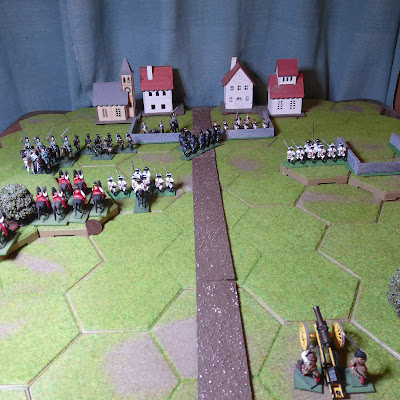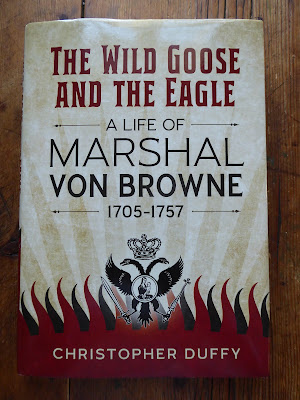Twas the night before Xmas... and in the small town of Weihnachten, Prussian troops warily guarded the wagons containing supplies for their seasonal feast, having been warned that Austrian Grenzers were in the area..
 |
| Wot, no hexes? Prussians await old-school onslaught |
Having recently acquired some very pleasing model houses from The Works, I found that as they are really table decorations, they actually light up. So, a night action seemed very much in order. Not played too seriously, of course - this is the Ragged Soldier's works Xmas 'do'..
I've been meaning to try ( I confess, for the first time ) the elementary rules from Young and Lawford's 'Charge' , and this seemed an ideal opportunity - I have just about enough figures to stage a small action, similar in scale to their 'Blasthof Bridge'. So, the opposing forces as follows:
Deployed in and around the town, the Prussians under the command of Generalleutnant von Krapfen consisted of :
44th Fusiliers ( 22 line infantry )
Von Kleist Uhlans ( 16 cavalry )
1 Gun with 5 crew.
Their task was to defend the two supply wagons containing their Xmas dinner, which were quartered for the night in the main street, near the church. As they peered into the inky darkness beyond the lights of the town, the garrison did not know that an Austrian raiding party was indeed approaching, led by General Rupert den Baren. He could call on the following:
Botta Fusiliers ( 32 infantry )
Creutzer Grenze Hussars ( 16 cavalry )
Dismounted Grenze Hussars ( 12 skirmishing infantry )
The town of Weihnachten
lies at a 'T-junction' of two roads, one running East-West through the town, one stretching from the South, as far as
the town. Nearby to both South and East are small woods, and a minor
eminence lies to the South-East. For this game, I have dispensed with the hex terrain and gone back to a good old-fashioned green cloth and model hills, and the table is 3 feet square.
The
Prussians divided their Fusiliers into two companies, one on the
Eastern and one on the Southern edge of the town, with the gunners in a
walled enclosure at the South-Eastern corner. The Uhlans were
split into two squadrons, one just West of the town and one on the small
height to the South-East.
The Austrians similarly, had divided their infantry into two 'companies' and cavalry into two 'squadrons', the skirmishers acting as a single unit. They approached from the South and East roads - it might be tricky to co-ordinate attacks from both directions in the winter darkness.
 |
| Turn 1 : Hussars and Uhlans pass all unaware.. |
Given a night-time scenario, I wanted to introduce plenty of
uncertainty: given the nature of the Charge! rules, I also wanted to
keep things simple. So, I used a good old D6, as follows.
The Austrians would enter from the South and East table edges - each edge divided into 3 equal sections, labelled 1 to 6, each unit rolls a D6 to decide its entry point.
How many units each turn? Roll a D6 for Turn 1, scored 3 : three units. The remaining two units on turn two ( further dice rolls to decide exactly which units each turn ).
Thus entirely randomly selected, on Turn 1, enter the 2nd Hussar squadron and the dismounted skirmishers on the Eastern table edge, and the 1st Hussar squadron from the Southern edge.
Now for movement and 'spotting' in the dark: again, keep it simple:
Movement - it's hard to keep direction in the dark, and unseen obstacles may slow progress. So, roll a D6 for each moving unit. Score 1 or 2, veer 45 degrees left; 3 or 4, go straight ahead; 5 or 6, veer 45 degrees right. Also roll for Move Speed : score 1,2, or 3 - half speed.
Spotting - troops may quite easily miss each other in the darkness. At up to 6 inches distance, spotting is automatic, but at 6 to 12 inches must roll 4,5 or 6 on a D6 to spot an enemy unit, and at 12 to 18 inches, must roll 6. Units opening fire are automatically spotted by all others in line of sight. Once the enemy or the town is spotted, normal movement can resume, but until then, it's random!
So to the first Austrian move. The 2nd Hussar squadron and the Skirmishers in the East had clearly mastered this whole night marching thing, and pressed on straight towards the town at full speed, but in the South the 1st Hussar squadron immediately veered left, and did not spot the Uhlans on the hill - who in turn, did not see the passing Hussars.
Prussian first turn: to the East the approach of the Hussars had brought them within 6 inches of the 2nd Fusilier company - open fire! A ragged volley rang out, and the first casualty of the night was one Grenze Hussar - at short range, not very good shooting, they must have been a bit sleepy. The Prussian gunners were clearly fast asleep, and saw nothing. South of town, the Fusiliers spotted the wandering 1st Hussars, but were out of musket range. So far, so frustratingly/pleasingly random.
 |
| Turn 2. Hussars blunder into woods: Uhlans awake! |
On to Turn 2 : enter the Austrian line infantry, both on the Southern table edge. 2nd Company Botta admirably straight ahead, perhaps guided by the nearby road, while 1st Coy. veered left - directly towards the Uhlans on the hill. Meanwhile the 2nd Hussars East of town, stung by musketry, charged the Prussian fusiliers, while the Grenzer skirmishers probed towards the Northern edge of town, albeit at half speed ( Skirmishing foot only appear in the 'advanced' rules of 'Charge!', but the authors very sensibly suggest that advanced features can be optionally added as required. Movement rates and ranges were adjusted, to keep the right relationship with Line infantry speed and range ). The Prussian 2nd Coy. Fusiliers fired at the charging Hussars - 10 figures, dice for range vs. cavalry gave long range, so one dice. Rolled a 1 - no hits! Still half asleep? Then melee - the Hussars gleefully sabred two fusiliers, before both sides fell back. Short and sharp.
The stars of the show, however, were those blindfolded 1st Hussars - having veered left, they now pressed straight ahead at full speed, straight into a wood! And still, they saw no enemy. They had been spotted, however, by the Prussian 1st Fusiliers , who woke them up with a volley, emptying one Hussar saddle. Finally in the South, 1st Squadron Prussian Uhlans spotted 1st Company Botta , downhill and straight ahead - Charge!
 |
| Turn 3: closing in |
Turn 3 , the Austrian move saw the resolution of that Uhlan charge, and proof that these old school rules can be fast and furious. Botta 1st Company levelled their muskets, 'won' the dice roll for range, so close range , with 16 men rolled two dice - scored 5 and 6, and shot down six of the eight Uhlans! To add insult to injury, the two remaining Uhlans inflicted no hits in the resulting melee, and lost one more trooper. Only one out of eight survived! Quite a blow for the Prussians. Meanwhile, the erratic 1st Hussars emerged from the wood, looked around and promptly spotted 2nd Uhlans to the West of the town, while the skirmishing Grenze to the East of town started sniping at 2nd Fusiliers. With Hussars advancing again, things looked worrying for the Fusiliers; made worse by some of the skirmishers now infiltrating into the Northern part of the town, sniffing out those wagons.
Nothing daunted, Prussian musketry opened up, the 2nd Fusiliers hitting back at the Hussars who were again in front of them, and their gunners finally woke up and joined in with canister: 3 Hussars lost. In the South, 1st Fusiliers opened fire on 2nd Botta at close range - 3 hits, not bad shooting. However, West of the town their 2nd Uhlans dozed, failing to spot the approaching Hussars,,
 |
| Turn 4 : Grenzers smell Xmas dinner |
Turn the Fourth, and the Austrians now really pressed home their attacks. In the South, 2nd Coy. Botta and 1st Coy. Fusiliers continued their firefight, each inflicting 2 casualties on the other. In the East, the 2nd Hussars charged again at the Prussian 2nd Fusiliers : between the defensive fire and melee, honours even at 2 losses each, but those Fusiliers were being worn down rapidly, and had no support, and crucially behind them, Austrian skirmishers captured one of the supply wagons! Now battle was joined to the West also, with the fortuitously wandering 1st Hussar squadron charging the sleepy 2nd Uhlans in flank , dismounting 2 - a rude awakening. Things now looked very bad for von Krapfen's Prussians, and losses were tallied up : Austrian casualties were 12 out of 60, and Prussians 17 out of 43. The elementary 'Charge!' rules only concession to morale is 'when the number of casualties suffered by an army is more than half the number with which that army started the battle, that army is out of action...' Only five more losses would finish off the Prussians.
 |
| End of the affair: Prussians at bay, Grenzers everywhere! |
And on Turn 5, the final blow - Austrian musketry delivered it, with 2nd Coy. Botta in the South taking no less than four figures from 1st Fusiliers, and sniping from Grenze skirmishers another one from 2nd Fusiliers. To add insult, the skirmishers also laid hands on the second supply wagon, and out to the West, 1st Squardron Hussars charged again at 2nd Squadron Uhlans. who at least had been able to turn and face them this time. But that combat became irrelevant, with the Prussian losses reaching 22, therefore over 50% , and both supply wagons being led away by greedy Grenzers. 'Twas a terrible blow and a hungry Xmas day for those Prussians, ejected from the warmth of the town and denied their festive feast!
And a good game, of course! Fast and furious, as 'old school' games should be - those unfortunate Uhlans paid the price, and probably lost the game. Perhaps I should have given the defenders stronger forces, as once losses started to mount they reached 50% very fast. I had anticipated that the gun would be more effective - but its crew proved not very alert, and once the enemy got close in, its fire was often masked by its own Fusilier comrades. The small table made for rapid action, with fire being opened on Turn 1 and units very quickly involved in close combat, and my improvised night movement and spotting rules worked pretty well, I thought, introducing some entertainingly random outcomes, especially those wandering Hussars!
I hope you've enjoyed reading this, as I did both playing the game and reporting the outcome (special thanks to my old mate 'LiverpoolDave' for suggesting the title). I hope you have had a good Xmas break, given the circumstances many of us find ourselves in. Thanks especially for all your friendly and encouraging comments and support of this blog, which has certainly helped keep me going through these 'interesting times', and I hope will long continue to do so. Keep safe and well, everyone, and here's to a Happier New Year.





































